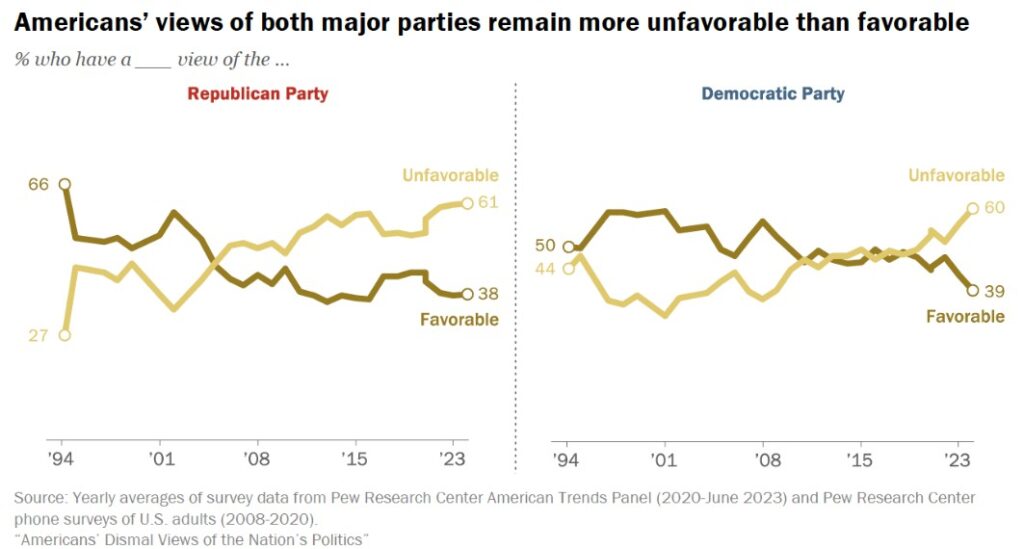Let’s Fix the Democratic Brand
To win elections, the Democratic Party must rebuild its brand.
It is not enough to just be against Donald Trump and the Republicans
Both parties have weaknesses, but this is an opportunity for Democrats
Current Public Perception of the Democratic Party
Extremely low favorability: Only 29% of Americans view Democrats favorably (CNN), and 27% per NBC, which is the lowest level in decades
- High unfavorable ratings: Around 55–57% express a negative view of the party
- Leadership deficiencies: Merely 16% see Democrats as strong leaders, and only 19% believe they can “get things done,” compared to 36% and 40% for Republicans
- Perceived elitism and disconnect: Many believe the party is “elitist,” “too politically correct,” and more focused on helping “others” not people like them; just 27% of independents think Democrats focus on them
- Internal party dissatisfaction: 58% of Democratic voters say the party needs major reform, and over half think leadership is steering in the wrong direction
- Economic credibility gap: Independents and swing voters trust Republicans more on inflation, economy, and middle-class concerns (by 5–7 points). Democrats are seen as weaker on “bread‑and‑butter” issues like jobs, wages, and inflation.
- Perceived extremism and internal division: 46% see Democrats as too liberal, and 51% say the party appears more divided than united. Forty-six percent of Democratic voters describe their own party as too extreme
- Disconnect with non-voters: Many non-voters lean economically populist but feel alienated by centrist messaging; mobilizing them could shift close elections
An Action plan to address this issue
Rebuild Trust Through Economic Populism and Working‑Class Messaging
Objective: Shift perception from elitism to genuine advocacy for working- and middle-class America.
- Adopt “social populism” including economic policies for working families (e.g. stronger unions, wage increases, Medicare, inflation relief), while maintaining mainstream social framing
- Launch relatable “kitchen table” messaging that highlights everyday impacts: childcare costs, prescription drug prices, job insecurity, union rights.
- Showcase policy wins or actionable plans, even if incremental—demonstrating effective governance and focus on real results.
- Promote local leadership and labor support: partner with unions, working-class advocates, small‑business owners to amplify real voices.
Clarify Leadership Identity and Showcase Competence
Objective: Counter leadership fatigue and restore confidence in Democrats’ ability to act.
- Identify credible spokespersons across demographics and promote them as party leaders
- Highlight legislative accomplishments, both local and federal—frame them concretely: “We achieved X for Y Americans.”
- Embrace disciplined communication: candid assessments of setbacks, paired with clear action plans.
- Invest in leadership development and generational renewal, accelerating visibility of younger, grassroots, and progressive rising stars
Refocus Messaging: Moderate Social Issues, Emphasize Values
Objective: Reduce perception of ideological extremism and reconnect across broader demographics.
- Reframe cultural issues in moderate, inclusive language: prioritize economic unity and social opportunity over identity politics
- Avoid “politically correct” backlash perception by emphasizing shared values (work, family, community) rather than polarizing rhetoric
- Promote bipartisan pragmatism where possible, especially on common-ground issues like infrastructure, healthcare affordability, and veterans’ services.
- Balance progressive ambition with realism: affirm core progressive ideals, but ground them in deliverable policy rather than rhetoric-heavy promises
Mobilize Non‑Voters and Disaffected Independents
Objective: Re-engage low-information, economically aligned non-voters and independent voters with economic messaging and community outreach.
- Target the 11% persuadable Trump voters who are socially moderate but economically progressive, through focused communication on jobs, healthcare, and cost of living
- Activate non-voters in key swing states, with community-based outreach, localized campaigns, and messaging tied to tangible benefits (e.g., student debt relief, Medicaid access) The Guardian.
- Boost grassroots organizing in all counties like urban, rural, red, purple, blue, through local offices, small‑donor funding, and listening tours like “Organizing Everywhere”
- Engage trusted local messengers, such as small business owners, educators, clergy, and union leaders, to deliver the message credibly to their communities.
Rebuild Party Brand: Unity, Action, Inclusivity
Objective: Rebrand as a united, results‑driven party aligned with mainstream values and working‑class priorities.
- Launch a branding campaign around slogans like “Working America First” or “Common Ground, Common Gains” that emphasize unity and shared progress.
- Demonstrate party unity by showcasing joint initiatives, bipartisan accomplishments, and cross‑faction cooperation.
- Enforce fiscal transparency and reduce corporate influence: push for campaign finance reforms, highlight small-donor fundraising, and candidly discuss priorities over profit
- Invest in renewal of internal party culture: empower younger candidates, embrace diverse ideological wings, and publicize participatory decision-making processes.
- Monitor impact and adjust messaging quarterly, using updated polls to refine tone and focus.
